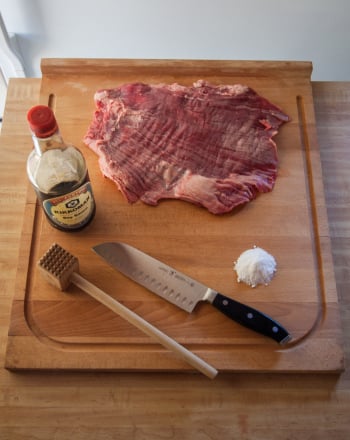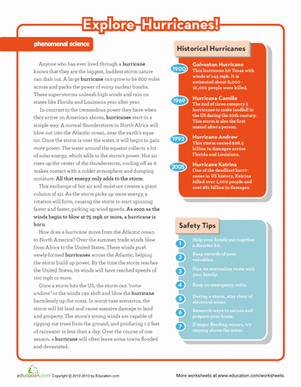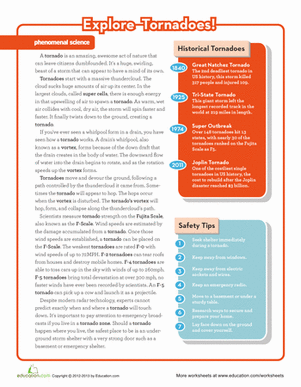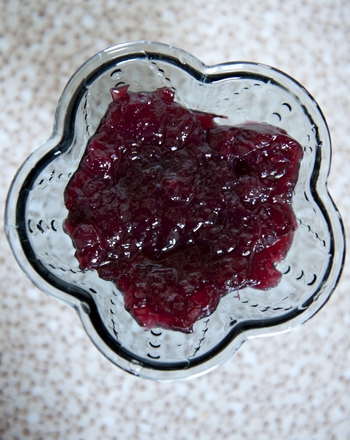Science project
Meat Science!
Discover the science behind the meat that you eat. Can science help you rock the barbeque? Let’s get cooking.
Problem:
What techniques tenderize meat most effectively?
Materials:
- One large flank steak at least 7 inches across
- Baking soda
- Cup
- 水
- Soy sauce
- 8 food safe containers
- Meat knife
- Tenderizing tool
- Toothpicks
- Masking tape
- Pen
- Barbeque and barbeque equipment
Procedure:
- You’ll be getting meat ready for the barbeque in several different ways. To begin, find an adult who can help you.
- Wash your hands and get a clean cooking surface ready. To cut the first piece of meat, look for the grain—the lines of fiber on the meat. Cut in the same direction as the grain and remove four three-inch slices of steak. Put them aside.
- Now, cut against the grain (perpendicular to the lines of fiber in the meat) to produce four more 3-inch slices of steak.
- Place each piece of meat into its own container, and make sure that you label the pieces you cut first as “With the Grain”.
- Start with the four pieces of steak that you’ve cut against the grain. Take the first one, get a teaspoon of baking soda and sprinkle it over the meat. Rub it in a bit if you wish. Place the meat in a container in the fridge overnight. In the morning, you’ll wash it thoroughly to remove the baking soda.
- Take the second piece of against-the-grain steak and place it in a bath of soy sauce. Place it in a container in the fridge overnight.
- Take the third piece of against-the-grain steak and pound it with a meat tenderizer for two minutes. Place it in a container in the fridge overnight.
- Leave the last piece of steak that you cut against the grain as it is, and place it in the refrigerator overnight as well.
- Repeat steps 5-8 with the steak pieces you cut in the same direction as the grain.
- When done, make sure you wash your hands. Always wash your hands after handling raw meat!
- Make sure each container is labeled so that you know which piece of steak is which. Create a hypothesis, your best guess about what is going to happen. What piece of steak will be the easiest to chew?
- Cook the pieces of steak. Once they’re off the barbeque, cut each piece into three smaller pieces so you have twenty four pieces of meat total.
- Put each piece of meat on the end of a toothpick. Make sure not to lose track of which pieces are which. To help keep track, label each toothpick with a number written on small piece of masking tape.
- Borrow three friends. Give each friend a piece of one of each types of differently tenderized streak (eight pieces total). Have your friends rank the pieces of steak in order from least chewy to the chewiest.
Results:
Meats cut with the grain will be chewier than meats cut against the grain. For both groups, the meat pieces that had no tenderizing methods applied to them will be the chewiest. The meat pieces that were tenderized with soy sauce and the pieces that were tenderized by pounding should both be softer than the meat pieces that had no tenderizing methods applied. Meat pieces with baking soda applied to them will be the softest.
Why?
While cooking meat on a barbeque might seem pretty easy, there’s a lot of science behind tenderizing meat to make it softer.
The steak you’re experimenting with is made out of cow muscle, and muscle is made up of fibers. And just like the fibers in wood, muscle fibers run in a particular direction, called the grain. When you pull in the same direction of the fiber’s grain, the muscle gets longer but doesn’t break. This means that when you slice the meat with the grain, you’ll get a piece of meat made up of long pieces of fiber like long lines of spaghetti, and it’ll be harder to chew. If you slice against the grain, you’ll have many small pieces of fiber, and the meat will be easier to chew.
People have many ways of making meat softer. Some are chemical reactions, while others involve physical pounding. Tenderizing meat by pounding on it is a way of making meat softer without using any chemical reactions. Instead, you’re using your own energy to break down the steak’s cell walls.
When you use soy sauce or baking soda, you’re using chemistry to make the meat softer. Have you made a baking soda and vinegar explosion? If so, you’ll know that baking soda reacts to acids in a big way. Baking soda is basic, and meat is slightly acidic. The chemical reaction that happens breaks down the proteins in the meat and makes it softer.
The soy sauce makes the meat softer in two steps. First, the acidic soy sauce softens the muscle fibers in the meat. Soy sauce is also very salty. The liquid in the meat’s cells is less saline, or salty, than the soy sauce. Therefore, some liquid flows out of the meat and the soy sauce flows in to replace it. The newly-arrived, acidic soy sauce dissolves some of the proteins in the cells, and the meat gets softer. This movement of liquid from an area with a lot of salt to an area with less salt is an example of osmosis.
Can you think of other ways to soften meat? Try them out next time you’re cooking dinner, and think about how science might help explain what happened!
Education.com提供了科学展览项目Ideas for informational purposes only. Education.com does not make any guarantee or representation regarding the Science Fair Project Ideas and is not responsible or liable for any loss or damage, directly or indirectly, caused by your use of such information. By accessing the Science Fair Project Ideas, you waive and renounce any claims against Education.com that arise thereof. In addition, your access to Education.com's website and Science Fair Project Ideas is covered by Education.com's Privacy Policy and site Terms of Use, which include limitations on Education.com's liability.
Warning is hereby given that not all Project Ideas are appropriate for all individuals or in all circumstances. Implementation of any Science Project Idea should be undertaken only in appropriate settings and with appropriate parental or other supervision. Reading and following the safety precautions of all materials used in a project is the sole responsibility of each individual. For further information, consult your state's handbook of Science Safety.













